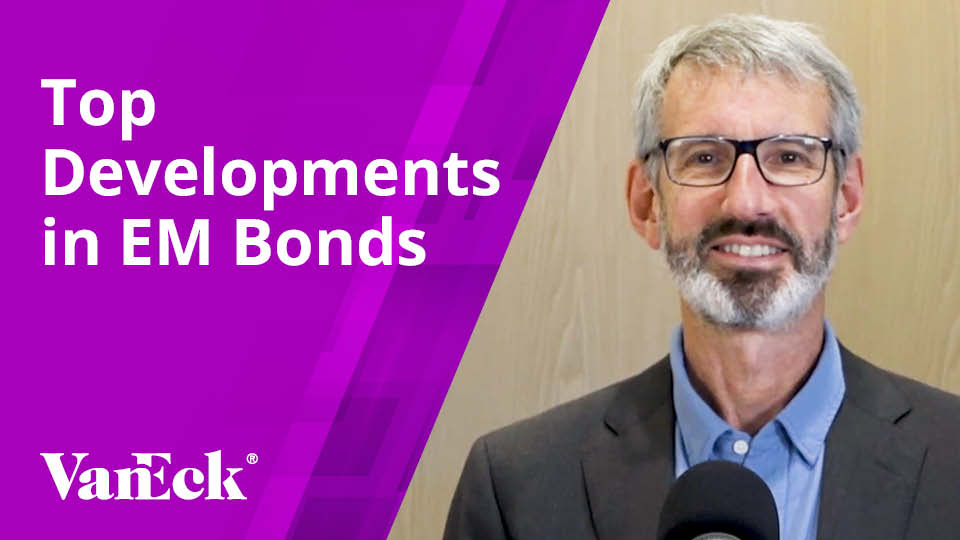Consider EM Local Currency Bonds as Rates Rise
23 May 2022
With yields over 7.6% (as of 30/4/2022), an allocation to emerging markets local currency sovereign bonds1 may be attractive as a way to diversify an income-oriented portfolio away from rising U.S. rates. Year-to-date, investors have not benefitted from the low correlation to U.S. bonds that has been observed historically. The asset class has returned -10.3%, which is only somewhat better than U.S. corporates and somewhat worse than the broad U.S. aggregate market.2 However, more than half of the negative return this year is attributable to the near complete loss of value of Russian bonds following the invasion of Ukraine, and an additional -2% of the year’s negative return has been driven by Eastern European countries most impacted by the conflict.3 Looking forward, we believe investors should consider the current makeup of the index, which has been relatively resilient and may benefit from several tailwinds.
Higher energy prices and commodity-led inflationary pressures have benefitted the currencies of several commodity exporting countries. In particular, the Brazilian real is up approximately 12.5% this year, contributing to most of the 13% gain in Brazilian sovereign bonds4 in U.S. dollar terms. The real’s gain is due in large part to the significant increases in the Brazilian central bank’s target rate over the past year to combat inflation (from 2% to 12.75%), as well as the positive impact of higher commodity prices on the country’s economy. Other Latin American currencies have also held their value (Mexican peso, Colombian peso) or appreciated (Uruguayan peso, Dominican Republic peso) versus the dollar this year, even as the dollar recently hit its highest level in nearly 20 years against developed markets currencies.5 In general, emerging markets central banks were far ahead of the Federal Reserve (Fed) and other developed markets central banks in hiking rates aggressively over the past two years. The result has been positive real rates of interest that have provided some support to currencies.
The yield advantage, in both real and nominal terms, helps to explain the relative resilience of the asset class in rising rate periods both currently (if one can adjust for the impact of geopolitical events) and historically. Further, although the Fed is at the beginning of what is expected to be a prolonged hiking cycle, historically higher U.S. rates have not been a headwind for investors once the U.S. hiking cycle actually begins. As shown in the chart below, the U.S. dollar appreciated in the year prior to the date of the first rate increase in three of the last five hiking cycles (including the current one). However, the dollar actually tended to be flat or weaker in the months following the first hike. If the same pattern repeats, emerging markets local currency bond investors may benefit from currency appreciation (or at least a pause in U.S. dollar strength) while earning higher levels of carry.
Broad U.S. Dollar and Historical Fed Rate Hiking Cycles
Source: VanEck Research, Bloomberg. Cycles refer to periods in which the Federal Reserve increased the Fed funds rate.
As witnessed earlier this year, the potential for unexpected geopolitical and macroeconomic shocks is always a risk. The growth slowdown in China and additional inflation surprises in emerging markets are two risks we are watching closely. But with emerging markets central banks having a head start on the Fed and consequentially having greater policy flexibility going forward, and with the yield advantage of emerging markets still at an attractive level (approximately 450 basis points) by historical standards, we believe there is adequate compensation for risk. As the Fed embarks on what is expected to be a sharp rate hiking cycle, the diversification potential of the asset class from a portfolio construction perspective should not be overlooked.
1Emerging markets local currency bonds measured by the J.P. Morgan GBI-EM Global Core Index.
2Morningstar as of 30/4/2022. Emerging markets local currency bonds measured by the J.P. Morgan GBI-EM Global Core Index; U.S. corporate bonds measured by the ICE BofA US Corporate Index; U.S. aggregate bonds measured by the ICE BofA US Broad Market Index.
3J.P. Morgan as of 30/4/2022.
4J.P. Morgan as of 30/4/2022.
5Bloomberg, as of 30/4/2022. As measured by the U.S. Dollar Index.
Wichtige Hinweise
Ausschließlich zu Informations- und/oder Werbezwecken.
Diese Informationen stammen von VanEck (Europe) GmbH, die von der nach niederländischem Recht gegründeten und bei der niederländischen Finanzmarktaufsicht (AFM) registrierten Verwaltungsgesellschaft VanEck Asset Management B.V. zum Vertrieb der VanEck-Produkte in Europa bestellt wurde. Die VanEck (Europe) GmbH mit eingetragenem Sitz unter der Anschrift Kreuznacher Str. 30, 60486 Frankfurt, Deutschland, ist ein von der Bundesanstalt für Finanzdienstleistungsaufsicht (BaFin) beaufsichtigter Finanzdienstleister. Die Angaben sind nur dazu bestimmt, Anlegern allgemeine und vorläufige Informationen zu bieten, und sollten nicht als Anlage-, Rechts- oder Steuerberatung ausgelegt werden. Die VanEck (Europe) GmbH und ihre verbundenen und Tochterunternehmen (gemeinsam „VanEck“) übernehmen keine Haftung in Bezug auf Investitions-, Veräußerungs- oder Retentionsentscheidungen, die der Investor aufgrund dieser Informationen trifft. Die zum Ausdruck gebrachten Ansichten und Meinungen sind die des Autors bzw. der Autoren, aber nicht notwendigerweise die von VanEck. Die Meinungen sind zum Zeitpunkt der Veröffentlichung aktuell und können sich mit den Marktbedingungen ändern. Bestimmte enthaltene Aussagen können Hochrechnungen, Prognosen und andere zukunftsorientierte Aussagen darstellen, die keine tatsächlichen Ergebnisse widerspiegeln. Es wird angenommen, dass die von Dritten bereitgestellten Informationen zuverlässig sind. Diese Informationen wurden weder von unabhängigen Stellen auf ihre Korrektheit oder Vollständigkeit hin geprüft noch können sie garantiert werden. Alle genannten Indizes sind Kennzahlen für übliche Marktsektoren und Wertentwicklungen. Es ist nicht möglich, direkt in einen Index zu investieren.
Alle Angaben zur Wertentwicklung beziehen sich auf die Vergangenheit und sind keine Garantie für zukünftige Ergebnisse. Anlagen sind mit Risiken verbunden, die auch einen möglichen Verlust des eingesetzten Kapitals einschließen können. Sie müssen den Verkaufsprospekt und die KID lesen, bevor Sie eine Anlage tätigen.
Ohne ausdrückliche schriftliche Genehmigung von VanEck ist es nicht gestattet, Inhalte dieser Publikation in jedweder Form zu vervielfältigen oder in einer anderen Publikation auf sie zu verweisen.
© VanEck (Europe) GmbH
Jetzt zum Newsletter anmelden
Verwandte Einblicke
Related Insights
08 Januar 2025
06 August 2024
23 Juli 2024
08 Januar 2025
06 August 2024
23 Juli 2024
16 April 2024
15 November 2023





